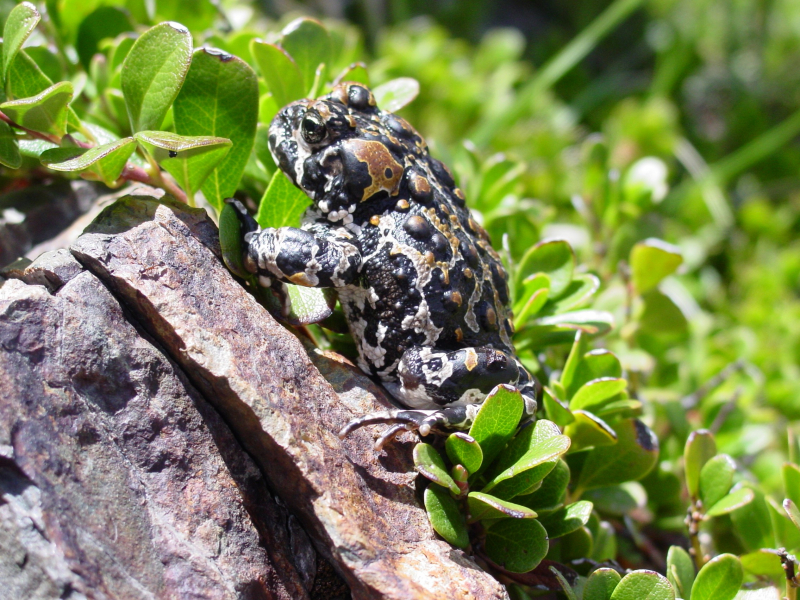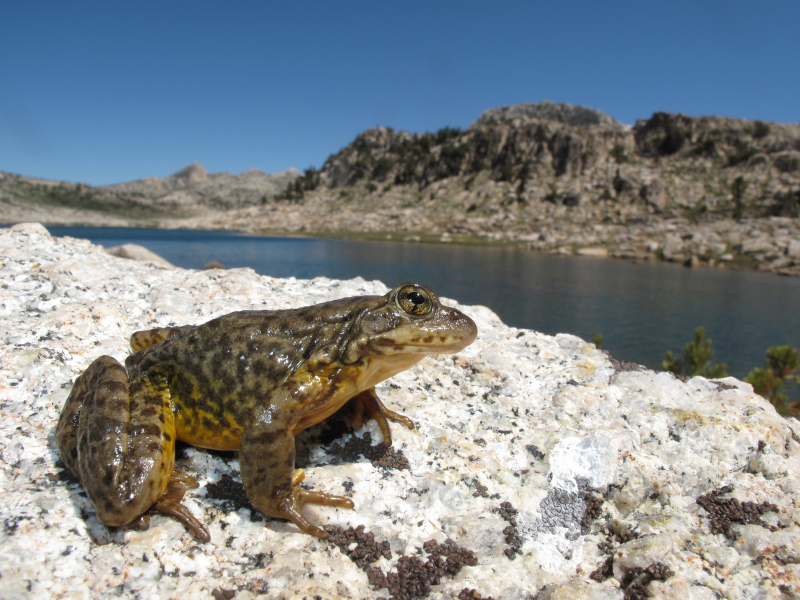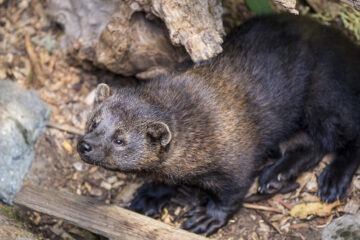What comes to mind when you think of Yosemite wildlife? Maybe black bears or coyotes, with their furry coats and perked-up ears, ambling through forests and meadows. Or Steller’s jays, those ubiquitous chatterboxes cloaked in brilliant blue feathers, flapping and floating from branch to picnic table and back again. You probably don’t picture the slithering, swimming and saltating cold-blooded critters that spend most of their lives in and around water and wetlands.
You’ll find many of the park’s 34 native amphibian and reptile species near lakes, ponds, rivers and streams. These sometimes scaly, sometimes slimy creatures might not be the first that spring to mind when you imagine animals in Yosemite, but they play important roles in Sierra ecosystems. Read on to meet a few, including some that are making a comeback thanks to our donors’ support!
California Red Legged-Frog (Rana draytonii)
 · You can recognize us by … our size (at up to 5 inches long, we’re the largest native frog in the western U.S.), and by the patches of red on our undersides.
· You can recognize us by … our size (at up to 5 inches long, we’re the largest native frog in the western U.S.), and by the patches of red on our undersides.
· We like to hang out … in California and Baja California (hence the name), mostly around ponds and slow-moving streams at lower elevations. Unlike yellow-legged frogs, we might wander far from water to find shelter in wooded areas or even in other animals’ burrows.
· You should know … we helped launch Mark Twain’s career (see “The Celebrated Jumping Frog of Calaveras County”), and are California’s state amphibian. Hunting, habitat loss and non-native bullfrogs pushed red-legged frogs toward extinction, and we were named a “threatened species” in 1996. With help from Conservancy donors, scientists have been working to give our species another chance, by creating a tadpole-rearing facility at the San Francisco Zoo and releasing hundreds of red-legged frogs in Yosemite Valley.
Mountain garter snake (Thamnophis elegans elegans)
![Mountain garter snake. Photo: Todd Battey [CC-BY-NC-SA-3.0]](/wp-content/uploads/d7/useruploads/blog_slimyscalysuper_mountain-garter-snake_todd-battey-cc-by-nc-sa-3.0.jpeg) · You can recognize us by … our three stripes: one on our backs (yellow, orange or white), and one on each side. So elegant!
· You can recognize us by … our three stripes: one on our backs (yellow, orange or white), and one on each side. So elegant!
· We like to hang out … everywhere from meadows to mountain lakes, in northern California, Oregon and western Nevada. We’re a subspecies of the Western terrestrial garter snake (Thamnophis elegans), but are often found near water, especially at high elevations in the Sierra Nevada, where we rely on amphibians as a primary food source.
· You should know … we’re not considered dangerous to people, though our saliva does contain toxins that could cause a reaction. Only one of our fellow Yosemite-dwelling snake species, the Northern Pacific rattlesnake, has venom that can harm humans. As with all wildlife, observe and appreciate snakes from a distance!
Western Pond Turtle (Actinemys marmorata)
 · You can recognize us by … our turtle-ness. Seriously, we’re the only turtle species in Yosemite. Our dark shells, which can be up to 8 ½ inches long, might look drab from a distance, but boast an intricate pattern of curved shapes and lines.
· You can recognize us by … our turtle-ness. Seriously, we’re the only turtle species in Yosemite. Our dark shells, which can be up to 8 ½ inches long, might look drab from a distance, but boast an intricate pattern of curved shapes and lines.
· We like to hang out … in and around ponds, rivers and lakes, especially if there are logs, boulders and banks where we can bask in the sun. We might wander from our watery homes to find food or lay eggs, and sometimes burrow into the mud to stay warm over the winter.
· You should know … we’re a California Species of Special Concern (and a candidate for the federal endangered species list), because of threats from habitat loss and other factors. With funding from Conservancy donors, park experts have been helping Yosemite’s turtle population by restoring us to our historical home in Yosemite Valley. (If you spot us along the Merced River, you might see small antennas attached to our shells — those help scientists keep an eye on us and figure out our habitat preferences.)
Yosemite Toad (Anaxyrus canorus)
 · You can recognize us by … our bumpy skin. Adult Yosemite toads of either sex have pale throats and bellies, but only females (and young toads) have a smattering of dark spots on their backs.
· You can recognize us by … our bumpy skin. Adult Yosemite toads of either sex have pale throats and bellies, but only females (and young toads) have a smattering of dark spots on their backs.
· We like to hang out … at high elevations within our limited range (a 150-mile span of the Sierra Nevada), in sunny meadows and patches of vegetation, usually no more than a few hundred feet from water.
·You should know … habitat degradation, disease and other drivers have caused our numbers to plummet, making us a federally threatened species (as of 2014). Conservancy donors have supported studies of Yosemite toad population size and distribution in the park, and have also funded projects to restore the wet meadow ecosystems on which we depend.
Pacific Treefrog (or Chorus Frog) (Pseudacris regilla)
 · You can recognize us by… our voice! They don’t call us the “chorus frog” for nothing. Listen for the ribbit call of male treefrogs, often used to stake out territory and attract mates.
· You can recognize us by… our voice! They don’t call us the “chorus frog” for nothing. Listen for the ribbit call of male treefrogs, often used to stake out territory and attract mates.
· We like to hang out … in a wide variety of habitats, but often on the ground (surprise!). We’re talented climbers, though, and can easily make our way up grasses, branches and rocks – we’ve even been spotted on the face of El Capitan.
· You should know … we’re the most common frog in Yosemite (and are found all over the western U.S.). While our call is easy to identify, we’re not so simple to spot. At only an inch or two long, we’re on the small side! Plus, we can change color quickly, prompted by shifting environmental conditions.
Mount Lyell Salamander (Hydromantes platycephalus)
 · You can recognize us by … our speckled appearance — we look a bit like slender sticks of granite with webbed feet.
· You can recognize us by … our speckled appearance — we look a bit like slender sticks of granite with webbed feet.
· We like to hang out … in the Sierra Nevada, where we’re an endemic species. We were first recorded by human observers in 1915 on Mount Lyell, Yosemite’s highest peak, and are usually found in damp, rocky areas at high elevations. That said, a few of us have been spotted around Yosemite Valley’s Bridalveil Fall (the focus of a Conservancy-supported restoration project).
· You should know … we lack lungs, so stick to moist environments where we can keep our skin wet to facilitate respiration. We’re excellent climbers, thanks to our webbed toes and sturdy tails. Oh, and we can cause temporary blindness if you touch us. So steer clear!
Sierra Nevada Yellow-Legged Frog (Rana sierrae)
 · You can recognize us by… our yellow legs (and belly).
· You can recognize us by… our yellow legs (and belly).
· We like to hang out … in high-elevation lakes, ponds, streams and wetlands, usually in water (or within jumping distance).
· You should know … that we’re endemic (limited to) the Sierra Nevada, where our species population was decimated in the 1900s, making us federally endangered. Now, thanks to years of work supported by Conservancy donors — including using environmental DNA (eDNA) to find frog-friendly lakes in Yosemite’s high country, and carefully relocating Rana sierrae to fish-free habitat — our species is rebounding, with populations increasing by 10 percent annually.
In case it wasn’t clear from our habitat preferences, we depend on water-saturated environments. During the 2012-2016 drought, our wetland homes suffered. In 2016, as part of species restoration efforts, a park-based crew rescued thousands of yellow-legged frog tadpoles from a drying meadow:
Your gifts make a difference for Yosemite animals of all shapes and sizes — including the creatures that slide, hop and splash under the radar of most park visitors. Learn more about our current wildlife grants, and get inspired to get involved!



